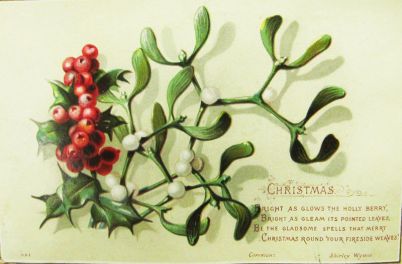Right so first of all apologies for the lack of articles recently, but as every GCSE student knows the month of November is entirely centred around achieving the forecast mock exam results. Apologies aside in the interest of the festivity of this season, what does the Holly and the Ivy symbolise?
The importance associated with these plants is not as some may think it a Christian phenomenon, more correctly it’s foundation predates Christianity and instead was an important Druidic symbol which was then adopted by Christianity. The use of Holly was highly ritualised and there are reports of Druids wearing it as a form of ceremonial headwear in Northern Europe, when they processed to observe the harvest of Mistletoe by their priests. Many Druidic cultures believed that Holly remained evergreen throughout the Winter months to ensure that the land remained beautiful, when their most sacred plant the oak lost its leaves.
The Romans also believed that the Holly and Ivy plants held importance, as Holly was the sacred plant of one of their God’s Saturn, and because of this was used at the feast of Saturnalia to honour him. Saturnalia was a celebration of the last harvest and the sowing of a new autumn crop, it was a time where informal clothing could be worn, gambling was allowed in public, children were allowed out of school and were given gifts by adults, wild behaviour was accepted and slaves could act disrespectfully to their masters. Holly and Ivy garlands or wreaths were given as gifts as they were believed to be gifts that inspired luck and good fortune, especially if subsequently used to adorn effigies of the God. Then on July 19th 64AD, the city of Rome was set ablaze and rumours circulated that the Romans own Emperor Nero was solely responsible, in a panic to prevent these rumours (which are now thought to be true) Nero blamed a group of the populace who were already persecuted and feared because of their beliefs, Christians. As a result of this, persecution of the Christian faith increased and with the number of practitioners also increasing, Christianity began to develop into a mainstream religion with its own set of holidays. One of which was Christmas, by coincidence this celebration coincided with the Roman celebration of Saturnalia, to avoid persecution many Christians adorned their homes with Holly and Ivy garlands so as not to cultivate suspicion amongst their neighbours, whilst inside their homes they celebrated Christmas in groups.
The associations of Holly and Ivy with Christmas and indeed the season persisted throughout the centuries as is evidenced with the number of songs that have been written concerning them or their symbolism. Indeed even Henry VIII wrote a love song concerning the virtues of Holly and Ivy ‘Green groweth the holly’ which concerns holly and ivy resisting the onset of winter and remaining evergreen ‘So I am and ever hath been Unto my lady true’, which he wrote and composed for Catherine of Aragon. However the most well-loved and well-known Christmas carol concerning the virtues of Holly and Ivy has to be ‘The Holly and the Ivy’ which was reputedly first mentioned in a Broadside of 1710, according to the book Early English Lyrics by Chambers and Sidgwick published in 1926.
It begins …
The holly and the ivy
Now are both well grown
Of all the trees that are in the wood
The holly bears the crown
Another such old carol is contained within a manuscript preserved at the British Museum, which was then published in 1823 in a book entitled Ancient Mysteries Described: Especially the English Miracle Plays founded on Aprocryphal New Testament Story extant among the unpublished manuscripts in the British Museum by William Hone (1780-1842).
-
Nay, my nay, hyt shal not be I wys,
Let holy hafe the maystry, as the maner ys:
Holy stond in the hall, faire to behold,
Ivy stond without the dore, she ys ful sore acold,
Nay, my nay etc
Holy and hys mery men, they dawnseyn and they syng,
Ivy and hur maydyns, they wepen and they wryng.
Nay, my nay etc’
Or in more modern language collected by Cecil Sharp (1859-1924) from Chipping Campden, Gloucestershire, relates also to another carol which is known as ‘The Contest of the Ivy and the Holly’.
-
Holly stands in the hall, fair to behold:
Ivy stands without the door, she is full sore a cold.
Nay, ivy, nay, it shall not be I wis;
Let holly have the mastery, as the manner is.
Holly and his merry men, they dance and they sing,
Ivy and her maidens, they weep and they wring.
Nay, ivy, nay, it shall not be I wis;
Let holly have the mastery, as the manner is.
- The aforementioned Contest of the Ivy and the Holly, is traditionally thought of as a contest between female (ivy) and male (holly) symbolism. In several social history manuscripts of the time there is evidence that in village life in ancient Britain there was a midwinter custom of holding and performing singing contests between men and women, in which men sang carols praising Holly for its masculinity and condemning Ivy, whilst women sang carols praising Ivy for its femininity and condemning Holly.
- Holly has become a symbol of peace and joy, so Holly trees became place to settle arguments as they would help create lasting peace. Lots of superstitions have developed around Holly including the belief that it has the power to frighten away witches and protect a home from thunder and lightning. In England, farmers sometimes placed holly on their beehives, because they believed that on the first ever Christmas the bees hummed in honour of Christ’s birth. The hanging of either Ivy or Holly on a door or in the house first would determine which gender would rule the household for the following year, however it was bad luck to do so before Christmas Eve. This was also believed in the case of ‘she holly’ (smooth leaved holly) and ‘he holly’ (prickly leaved holly) e.g. if ‘she holly’ was hung on the door the female of the household would rule it for the year. In Germany it was believed that a piece of holly used in church decorations would be an effective charm against lightning. In west England it was thought that placing holly around a girls bed on Christmas Eve would protect her and keep away goblins. Holly was thought at this time of year to bring sweet dreams and a tonic of it was thought to cure a cough and ivy was still believed by some to cure hangovers (which was originally a Roman belief).
So remember the importance of Holly and Ivy to almost all religions, respect it and its cultural importance. But most of all have a,
Merry Christmas Everyone!

